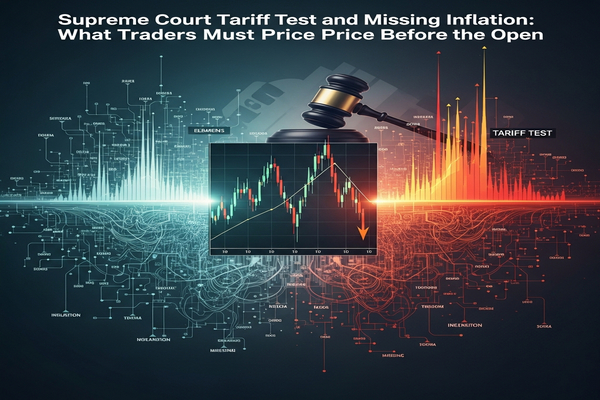
The Supreme Court will hear a case this week that will decide whether a president can use a nearly 50 year old emergency law to impose broad import tariffs. The outcome matters now because markets have already priced in uncertainty and because a ruling could change trade policy quickly. Short term this raises volatility in equities, bonds and currency pairs. Long term it could reshape trade flows across the US, Europe, Asia and emerging markets compared with previous tariff episodes.
Supreme Court showdown and immediate market implications
The court will weigh whether the International Emergency Economic Powers Act allowed the administration to levy tariffs that it argued were needed to address trade imbalances. Plaintiffs say the law does not grant tariff authority and that a persistent trade deficit is not an emergency. The Department of Justice counters that courts should defer to the president’s view of an emergency and that the tariffs give the president leverage to address problems quickly.
Traders should expect two practical consequences from a decision that limits the administration’s power. First, a ruling for the plaintiffs could trigger refund claims and tax revenue losses that have supported recent fiscal math. Second, the decision would force policymakers to rely on slower, process heavy trade authorities that make policy changes more predictable but less nimble.
Global markets have been unsettled since the tariff program began. A court decision that removes the quick on and off switch would likely calm some cross border risk premia, especially for exporters and global manufacturers. Conversely, a ruling that upholds the emergency authority would extend policy uncertainty and keep risk premiums elevated. Equities with heavy exposure to imported intermediate goods may be the most reactive in the near term. Bond yields could move on the revenue implications. Currency moves would track exporters and interest rate expectations.
Inflation readings and the odd case of missing price pressure
Recent data show the goods-heavy portions of inflation have risen but not jumped. The Institute for Supply Management reported its manufacturing purchasing managers index slid to 48.7 percent in October, signalling contraction and slower price gains. That matters because slower manufacturing activity reduces pass through of import taxes to consumers and can weigh on corporate pricing power.
Analysts at Pantheon Macro lowered their estimate of tariff driven impact on the Fed’s preferred inflation gauge. They now see tariffs adding 0.7 percentage point to core personal consumption expenditures this year down from nearly one point previously. The change reflects lower tariff revenues and some substitution away from imports toward domestic alternatives. Pantheon expects core PCE to peak near 3.1 percent in December and to drift toward 2.5 percent by the end of next year.
Not everyone sees the path the same way. J.P. Morgan, trading under NYSE:JPM, warns that pass through may be slower but more prolonged, producing a lower peak but a longer period of elevated inflation. Businesses appear to be absorbing portions of tariff costs rather than passing them fully to consumers. Some distributors are assumed to shoulder around 30 percent of added costs, which hits profits and possibly payrolls before it hits consumer prices.
What to watch in today’s session
Markets will trade in a context set by the court hearing and recent data. Expect heightened sensitivity in cyclical sectors and in assets tied to global trade. If headlines emphasize judicial skepticism about using the emergency law for tariffs, risk assets may rally and safe haven flows may reverse. If coverage highlights deference to the executive branch, expect widened risk premia and a bid for defensive sectors.
Fixed income desks will focus on the fiscal angle. A finding against tariff authority could reduce projected tariff receipts and change Treasury supply expectations. That would push traders to reprice nominal and real yields. Currency desks will watch US yield changes alongside trade policy cues. Emerging market currencies that depend on export demand could see outsized moves compared with majors.
Commodities traders should track both policy signals and the ISM print. A weaker manufacturing backdrop reduces demand for industrial metals and freight. Oil markets will react to growth expectations and to any geopolitical commentary tied to trade or sanctions policy. Meanwhile investor positioning in risk sensitive assets may be thin, so headlines could produce outsized intraday moves.
Scenarios for positioning and risk management
There are three basic scenarios traders should price. One, the court limits the emergency tariff authority. This would likely lower near term policy uncertainty and be positive for cyclicals and global trade dependent assets, though it would raise questions about refunds and fiscal effects. Two, the court upholds the authority. That outcome would extend uncertainty and could keep risk premia elevated across equities and credit. Three, a narrow or mixed decision would leave many questions unresolved and keep markets choppy.
Risk managers should monitor sector exposure to imports and exports. Industrials, consumer discretionary and retailers face direct input cost and margin pressure. Banks and financials will watch potential impacts on loan demand and corporate credit. Currency traders should keep stops tight around headline driven sessions because liquidity can dry up when traders reposition around legal developments.
Finally, watch how firms respond in public statements. Several large economies have negotiated tariff rollbacks for certain goods. That trend has muted a larger inflation burst so far. If businesses continue to absorb costs or substitute goods, the immediate inflation impulse will remain contained. However, if firms start fully passing through costs, the inflation story and market reaction would look different.
Traders should treat this session as an information event. Headlines from the courtroom will matter. So will incoming data about manufacturing and prices. Position size and stop placement matter more than usual because the legal timetable could change the policy framework quickly and materially.
Note NYSE:BP appears in the sponsor material describing refinery investments and US job support. That activity is part of the backdrop for energy and industrial demand discussions this week.












